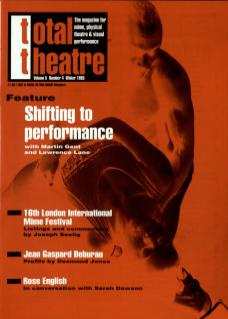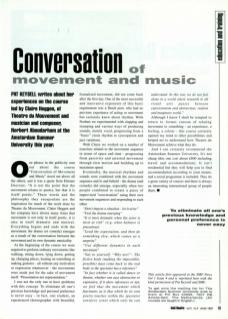One phrase in the publicity sent out about the course ‘Conversation of Movement and Music’ stood out above all the others, and it was a quote from Étienne Decroux: ‘It is not the point that the movement relates to poetry, but that it is itself poetic.’ These words and the philosophy they encapsulate are the inspiration for much of the work done by Théâtre du Mouvement. Claire Heggen and her company have shown many times that movement is not only in itself poetic, it is also in itself dramatic and musical. Everything begins and ends with the movement, the drama (or comedy) emerges as a result of the conversation between the movement and its own dynamic musicality.
At the beginning of the course we were required to perform ordinary movements like walking, sitting down, lying down, getting up, changing places, leaning on something or making gestures – all without any motivation or expression whatsoever – the movements were made just for the sake of movement itself. ‘Presentation not representation.’
I was not the only one to have problems with this concept. To eliminate all one's previous knowledge and personal preference is never easy – in fact, one student, an experienced choreographer with beautiful, formalised movement, did not come back after the first day. One of the most successful and innovative exponents of this basic requirement was a Dutch poet, who had no previous experience of acting or movement but certainly knew about rhythm. With Norbert we experimented with clapping and stamping and various ways of producing sounds, mostly vocal, progressing from a ‘basic’ clock rhythm to syncopation and jazz variations.
With Claire we worked on a number of exercises related to the movement sequence in terms of space and time – progressing from passivity and arrested movement through slow motion and building up to maximum speed.
Eventually, the musical rhythms and sounds were combined with the movement sequence and lo and behold – the drama (and comedy) did emerge, especially when two people combined to create a piece of ‘improvised conversation’ using their own movement sequences and responding to each other.
‘Don’t impose a situation – let it arise.’ ‘Feel the drama emerging.’ ‘It is most dramatic when the actor is most at risk.’ (e.g. When balance is precarious.) ‘Lead the expectation, and then do something else, which comes as a surprise.’ ‘Use different dynamics in each movement.’ ‘Say to yourself, "Why not?".’ ‘The fictive body (making the impossible, possible) must come back to the real body so the spectator has a reference.’ ‘In fact whether it is called dance or theatre, whether one says abstractive or expressive, if it shows references or not we feel that the movement which fascinates us is that which by its own poetry touches within the spectator sensitive zones which only he can understand. In this way we do not feel alone in a world where research in all visual arts passes between expressionism and abstraction, realism and imaginary world.’
Although I know I shall be tempted to return to former custom of relating movement to something – an experience, a feeling, a colour – this course certainly opened my mind to other possibilities and helped me to understand how Théâtre du Mouvement achieve what they do.
And I can certainly recommend the Amsterdam Summer University. It's not cheap (this one cost about £800 including travel and accommodation) and it isn't residential, but they will help you to find accommodation according to your means, and a social programme is included. They do a great variety of courses and there is always an interesting international group of people there.
This article first appeared in the SMF News Vol 1 Issue 4 and is reprinted here with the kind permission of Pat Keysell and SME.

